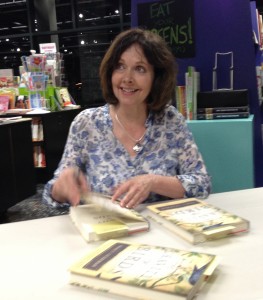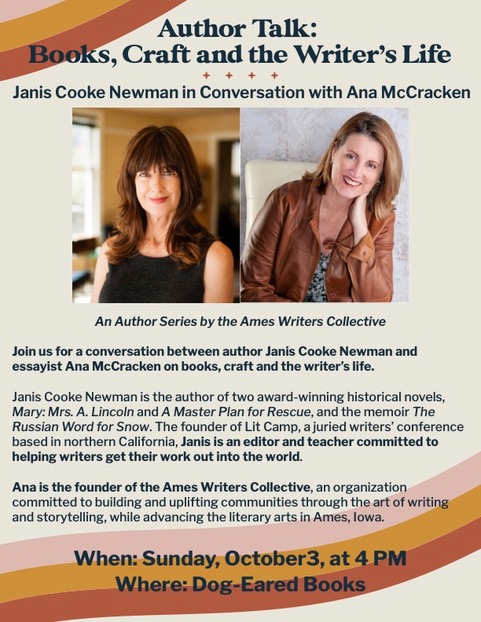
When I learned that Tracy’s book The Gravity of Birds was to be published in July 2013, I was thrilled. Success of fellow writers is inspiring. A page-turner, I read The Gravity of Birds in less than a week (A week’s fast for me. I’m a slow reader.) In this compelling debut novel, an art authenticator and an art historian are employed by a famous, reclusive painter to sell a never-before-seen portrait. The search for this portrait leads the two men to discover devastating secrets two sisters kept from each other, and from the reclusive artist who determined the course of their lives.
 Reviews for The Gravity of Birds, were great. O, The Oprah Magazine called it a “richly textured novel…” The San Francisco Chronicle said, “If literary fiction is on the verge of extinction, Bay Area writer Tracy Guzeman’s debut novel, “The Gravity of Birds,” ought to inspire new hope for an endangered species.” And Booklist: “Talented…incredibly assured…her cast of endearing eccentrics and her stellar prose will win a loyal audience.” Personally, I bought six books and sent them to friends around the country.
Reviews for The Gravity of Birds, were great. O, The Oprah Magazine called it a “richly textured novel…” The San Francisco Chronicle said, “If literary fiction is on the verge of extinction, Bay Area writer Tracy Guzeman’s debut novel, “The Gravity of Birds,” ought to inspire new hope for an endangered species.” And Booklist: “Talented…incredibly assured…her cast of endearing eccentrics and her stellar prose will win a loyal audience.” Personally, I bought six books and sent them to friends around the country.
Last July after the release of her novel, Tracy sat down with me for an interview. It’s March now! For accuracy, I tape and spend the time to transcribe every word of my interviews. That said, I’m remiss and chalk up my delinquency to my writers’ procrastination. Forgive me, Tracy. But perhaps, posting the interview now will generate more book sales.
ANA—When did you decide you wanted to be a writer?
TRACY—Growing up in Illinois, I loved to write, but I couldn’t see how I could make a living at it. I considered journalism as a college major, but didn’t think I’d be able to maintain the necessary distance between writer and subject. I chose to study landscape architecture at Iowa State University because it was close to home, and had a beautiful campus. (Tracy and I share the same alma mater!) After graduation I worked at a garden and nursery company in Des Moines. Meanwhile, my family members had migrated to California. During the recession, I followed. I took native plant materials classes at UC Berkeley to continue with my career in California, but eventually the lack of seasons caused me to switch my work to marketing and eventually event management. I own my business.
ANA—At what point did you start writing again?
TRACY—I never really stopped writing. I was always working on short stories, just to entertain myself. Writing was both a release, and a way to stay grounded. At one point, I began taking classes at Stanford, in their Continuing Education program, and then with Ellen Sussman. I think it was in Ellen’s class that I started to picture something bigger for my writing. Sporadically, I’d send stories out as sort of an exercise, to see if I could get comfortable with the idea of having someone who wasn’t related to me reading what I’d written. But the idea of a novel was daunting. Twenty pages or so was a very comfortable length for me.
ANA—Where did you find the inspiration for The Gravity of Birds? Never thinking of anything bigger than short stories, what inspired you?
TRACY—I had two short stories I’d been working on for a long time. I liked the characters in both stories, but couldn’t figure out how to give them the end they deserved. I was moving at the time, and packing up an old oil painting—a family portrait of my great, great, great grandmother and her two daughters. As I packed it up, I was thinking about my two stories. One was about a young man with high aspirations, recently graduated from college with a degree in the arts. Through a series of circumstances, he finds his career path taking a downward spiral. The other story was about the burden caregiving places on a pair of siblings. As I wrapped up the family portrait, I realized that not only were the two women in the painting daughters, they were also sisters. An obvious thought, but one I hadn’t really considered before. What if I placed the sisters in the story about siblings and caregiving? What if the painting was found by the young man in the other story? What if, I wondered, he worked for an auction house? At the same time, I had an agent who was waiting for a finished novel. It pushed me to write.
ANA—How long did it take you to write the novel?
TRACY—About six months.
ANA—Six months? Seriously? That’s quick.
TRACY—I know it sounds short, but I’d been working on those two stories for a long time. Once I made the connection, then the rest came quickly. I had some down time in my work schedule, so could spend a lot of that sitting at my desk, writing.
ANA—Ellen Sussman once used you as an example in her class as someone who does all her research on the web. You didn’t go anywhere. It occurred to me while I was reading The Gravity of Birds that you never tell us where we are, except for the reference to New York City. I have another author friend who believes he has to visit locations he’s writing about in order to be accurate. Ellen does the same thing.
TRACY—I think there are lots of authors who write about specific places and use recognizable place names, and feel it adds something important to the story. But for The Gravity of Birds, I drew on memories of places I’d visited, then cut and pasted to create my fictional world. I wanted the reader to get lost in the story, and not focus too much on a particular setting or location with which they were already familiar. I did a lot of research: verifying native plant materials of upstate New York; familiarizing myself with art terminology (because I’ve been to a lot of museums but I’m definitely not an artist); reading up on rheumatoid arthritis. There’s a wonderful book called The Tenderness of Wolves by Stef Penney. It’s about a murder that takes place in the northern territories, and the setting is painted in incredibly rich detail. After reading the novel, I found out the author has agoraphobia; she’d never set foot in Canada. Instead, she did all of her research in the libraries of London. Andrea Barrett is another author I admire. She too, does a great deal of her research in libraries. She reads old newspapers from the time period she’s writing about, as opposed to using the internet for research, because she wants to write from the same perspective as her characters. I’d be fine traveling someplace to do research, but I don’t think it’s a requirement.
ANA—What types of challenges did you face while writing The Gravity of Birds?
TRACY—Shortly after I started working on the book, Ellen hosted a master class with Amanda Eyre Ward, the focus of which was plotting your novel. One of the techniques Amanda used was mapping out specific scenes on index cards, then moving the cards around as she worked through the plot. The thought of that much structure sort of terrified me. I’d always assumed my process would be very organic, with one idea just naturally flowing into the next. HA! Somewhere around 120 pages, I had a minor meltdown. My narrative shifts back and forth in time, and there are three different point of view characters. I found I was losing track of things: what were my characters’ ages in any given year; what social issues would have influenced their perspectives; what technology would have been available to them, etc. I tossed organic out the window and opted for a simple spreadsheet where I could make note of the chapter number, the year it takes place, the location and the narrator, and then a sentence or two about what had to happen in that chapter. Not what did happen, only what needed to happen in order to move the story along. The Gravity of Birds is a mystery. I knew the ending, but I didn’t know exactly how I was going to get there. The spreadsheet became a roadmap for moving forward.
ANA—How was the rewrite for you? I used to lead writing practice groups and what I found from the writers who participated, was that they believed they could pop out a story or a novel in “one draft.” The idea of rewriting flummoxed them. Did you get lucky on your rewrite too?
TRACY—(Laughs) I write slowly and I’m changing things in my head before they ever get on the page. I turned in the first draft of the novel to my agent, and she was enthusiastic about it. She gave it to someone else in her office to read, and that person thought three of the main characters could be cut. I thought about it, but decided I couldn’t make those changes. I honestly felt I would be willing to do whatever was necessary to make the book better, but making those changes would only make the book shorter! She came back with a few, very specific suggestions for revisions which I thought made sense for the story. In the meantime, I’d asked a trusted friend for his feedback and he gave me some brilliant advice. He said he knew I loved my characters. But what I hadn’t done was to make this person who’d thought they could be eliminated love them, too. AHA! This made perfect sense. I realized there were things about my characters I was still carrying around in my head, things that I knew about them, but no one else did, because I hadn’t put them down on the page. For the next month, I read through the book and found places where I’d left things out—things that would allow the characters to be more real and accessible to the reader. Those additions made the difference, so I guess I’d say most of my rewriting for this book was more along the lines of drain the brain. But I think the process, and the challenges, are likely different with every book.
ANA—Every writer will want to know what your writing life is like. You work. When do you find the time?
TRACY—I’d like to be more disciplined. My goal is to write three pages a day. I’m very effective at stalling—if I only do two pages, I can fill up space, but not really move the story forward in any meaningful way. But three is the magic number for me; it’s harder to stall for three pages, something has to happen. As far as a schedule, it varies. Sometimes I write in the early morning, sometimes late afternoon into evening. The middle of the day isn’t a particularly creative time for me, so that’s when I try to get other things done. When I get close to the end of a project, whether it’s a novel or a short story, I sort of get tunnel vision and I’m glued to my desk. At that point, it’s easier to stay in the fictional world I’ve created than it is to drag myself out of it to do things like eat, dress, exercise. I wouldn’t say my writing habits are healthy. (Laughs.) My process definitely needs improvement!
There’s no getting around it: if you want to be a writer, you have to write. You may have a brilliant idea for a novel or a short story in your head, but if you don’t put it down on paper, that’s where it will stay—in your head. And someone else who does make or find the time will write that story instead.
I’ve been incredibly lucky and fortunate, but also very selfish. There’s really only one reason I write: it makes me happy. I didn’t have any expectations of getting published when I started, which was a good thing. The business being what it is, the odds of being disappointed are high if that’s your only goal. But if you’re writing because nothing makes you happier, then you’re writing for yourself. Because you have a story you want to tell. So put your butt in the chair and tell your story.
ANA—Like sitting down and reading a good book.
TRACY—Yes. If reading books makes you happy, you always find the time to do that. Writing shouldn’t be any different.
ANA—What’s something some people might know about you, but others don’t?
TRACY—I’m secretly an introvert. My closest friends know this, but because I’ve worked in meeting planning for such a long time, I think people assume otherwise.
ANA—And now you and The Gravity of Birds are out there in the world.
TRACY—Yes. I wrote the book not really thinking that anyone else would read it, but once we went out with it, things happened very quickly. The book really takes on a life of its own, and all of the sudden it’s out there in the world. It’s a strange feeling. But a good one.





I enjoyed reading your interview.
Thank you, John! Cheers!